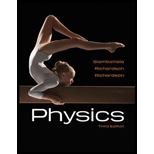
Concept explainers
(a)
The speed of the selected neutrons escaping the reactor.
(a)
Answer to Problem 66P
The speed of the neutrons is
Explanation of Solution
The time interval between the two shutters is
Write the expression for speed.
Here,
Substituting
Thus, the speed of the neutrons is
(b)
The de Broglie wavelength of the neutrons.
(b)
Answer to Problem 66P
The de Broglie wavelength of the neutrons is
Explanation of Solution
The velocity of the neutrons is
Write the expression for de Broglie wavelength
Here,
Substitute
Here,
Substitute
Thus, the de Broglie wavelength of the neutrons is
(c)
The range of de Broglie wavelength.
(c)
Answer to Problem 66P
The range of de Broglie wavelength is
Explanation of Solution
The slowest neutron takes longer time to get through the shutters. It is given by the sum of the time interval between the two shutters and the time the two shutters are open i.e.
Here,
However, the fastest neutron takes lesser time and it is given by the difference of the time interval between the two shutters and the time the two shutters are open i.e.
Here,
Substitute
Substitute
Thus, the speed of the slowest neutrons is
Substitute
Thus, the de Broglie wavelength of the fastest neutrons is
Substitute
Substitute
Thus, the speed of the fastest neutrons is
Substitute
Thus, the de Broglie wavelength of the slowest neutrons is
Thus, the range of de Broglie wavelength is
Want to see more full solutions like this?
Chapter 28 Solutions
Physics - With Connect Access
 College PhysicsPhysicsISBN:9781305952300Author:Raymond A. Serway, Chris VuillePublisher:Cengage Learning
College PhysicsPhysicsISBN:9781305952300Author:Raymond A. Serway, Chris VuillePublisher:Cengage Learning University Physics (14th Edition)PhysicsISBN:9780133969290Author:Hugh D. Young, Roger A. FreedmanPublisher:PEARSON
University Physics (14th Edition)PhysicsISBN:9780133969290Author:Hugh D. Young, Roger A. FreedmanPublisher:PEARSON Introduction To Quantum MechanicsPhysicsISBN:9781107189638Author:Griffiths, David J., Schroeter, Darrell F.Publisher:Cambridge University Press
Introduction To Quantum MechanicsPhysicsISBN:9781107189638Author:Griffiths, David J., Schroeter, Darrell F.Publisher:Cambridge University Press Physics for Scientists and EngineersPhysicsISBN:9781337553278Author:Raymond A. Serway, John W. JewettPublisher:Cengage Learning
Physics for Scientists and EngineersPhysicsISBN:9781337553278Author:Raymond A. Serway, John W. JewettPublisher:Cengage Learning Lecture- Tutorials for Introductory AstronomyPhysicsISBN:9780321820464Author:Edward E. Prather, Tim P. Slater, Jeff P. Adams, Gina BrissendenPublisher:Addison-Wesley
Lecture- Tutorials for Introductory AstronomyPhysicsISBN:9780321820464Author:Edward E. Prather, Tim P. Slater, Jeff P. Adams, Gina BrissendenPublisher:Addison-Wesley College Physics: A Strategic Approach (4th Editio...PhysicsISBN:9780134609034Author:Randall D. Knight (Professor Emeritus), Brian Jones, Stuart FieldPublisher:PEARSON
College Physics: A Strategic Approach (4th Editio...PhysicsISBN:9780134609034Author:Randall D. Knight (Professor Emeritus), Brian Jones, Stuart FieldPublisher:PEARSON





